Abstract
Altruism is the moral to be cultivated, inculcated in the students personality, thus helping to prevent irresponsible behavior, the identification of positive, genuine, pro-social skills and social-emotional development. This is a goal that can be achieved by approaching effective teaching strategies based on active-participative methods and developed in a educational environment friendly, relaxing and nurturing. Altruism involves empathy, emotional need that students feel safe, feel that they are listened to, understood by the teacher and in turn, they show respect for others, active listening, understanding. The teacher's role is important to be an example for his pupils to be truly a "person" to be truly "human" and with respect, compassion, wisdom shown to his pupils. In our study we have dedicated this issue of major importance and we researched this phenomenon through the application of specific research methods sciences education, observation, survey-based questionnaire-based research thoroughly curriculum documents and school in force. In this respect, I supported lessons on internalization of moral value of altruism using the basic teaching game teaching method with its different variants because of its dynamism and generating good mood, emotional comfort and freedom of expression.
Keywords: Altruismempathypro-social behaviourpersonality
Introduction
Altruism is the moral value to be cultivated, inoculated into the pupils' personality, thus contributing to preventing irresponsible behavior, to highlighting positive, authentic, pro-social matters, as well as to developing socio-emotional skills. This is a goal to be achieved by approaching effective teaching strategies based on active-participative methods and developed in a friendly educational, relaxing and nurturing environment.
Altruism involves empathy, emotional need whereby pupils feel safe, they feel that they are listened to, understood by the teacher and in their turn, they show respect, active listening, understanding towards others. The teacher has got the important role to be an example for his pupils to be a real "person", to be truly "human" and through the respect, compassion, wisdom shown towards his pupils.
Practicing pro-social behaviors is a goal to be achieved by studying school subjects from the curricular area related to "Man and society", especially those of Civic education, a subject studied at the primary level, in the 3rd and 4th grades. Altruism represents such moral value manifested by generosity and by a benevolent and selfless behavior, to promote the welfare of another person, even if it means taking a risk (Barbu, Boca, & Călineci, 2016). In this context "the root of altruism lies in empathy, in the ability to read the emotions of others: do not feel the need or despair of others means a lack of affection (...) and if there are two moral attitudes our times would need, they are certainly self-abstinence and compassion" (Goleman, 2008, pp. 59-60).
Problem Statement
Altruism, among other "personal virtues" (sincerity, honesty, nobility, love, charity, responsibility etc.) and social virtues lie on the development of humanistic education expressed by values of a "pluralistic, participatory, collaborative and persuasive, consensus and diversity civic culture, enabling change, shaping it" (Chicu, 2002, p.33). It is therefore requested, as a contemporary and indispensable requirement, the formation of a humanistic personality, characterized through features and meanings such as: honesty, sincerity, kindness, humanness, generosity, faithfulness, nobility, modesty, respect, love, kindness and concern for people, gratitude and vigilance towards the family, parents; confidence in human values and capabilities of, civilized behavior, attentive and gracious in interhuman relationships, avoiding all forms of physical or moral insult, sympathy, care and help to the suffering people, deprived by calamities, disabled, elderly or having other needs, dignified and civilized coexistence between individuals of all ages and nationalities, understanding and cooperation between generations, the ability to offer joy to parents, elderly, etc., dignity, personal and national pride, loyalty towards the country and people, honoring the memory of all those fallen in battle, aversion to evil and to inhuman acts such as greed, adultery, murder, destruction, drug trafficking, etc., fight for ensuring peace, for preventing and eliminating conflicts on our planet etc. (Bontaș, 2007).
Formation and development of the specific skill related to the demonstration of pro-social behaviors as a socio-emotional competence is an ongoing and impact process on the design and finalization of the student character, of the personality relational-value side. Classroom is a psychosocial climate where can form interpersonal and intrapersonal relationship skills that will influence the moral conduct. The student builds its personal identity, forms its own personality, self-confidence, empathy, assertiveness and other personality traits desirable for a genuine and harmonious social life. Within the group-class along with the teacher, pupils internalize social and moral behavior rules and norms, initially imposed from the outside and subsequently transferred to the moral conduct, imposed from the inside.
Research Questions
The research questions are the following:
3.1. How important is the application of teaching strategies with playful character within Civic education classes in the 4th grade?
3.2.How altruistic are the pupils subject to questioning?
3.3. How do pupils in the fourth grade perceive the moral value of altruism at the level of inter-human relations?
Purpose of the Study
To support this idea, we developed an intervention program to develop this skill at the fourth grade, on a population of 185 pupils, over a school semester, distributed at the level of two samples, a control sample and an experimental sample. Therefore, in the context of Civic education classes, we approached a playful teaching and learning strategy, because it promotes learning in a relaxed and stimulating environment, based on interaction, on cooperation, but also on competition between groups of pupils who have a common goal and a common desire. We chose the role play as a basic teaching method, because, through games and activities based on cooperation, the student gains feelings of confidence and self-esteem, communication and empathy skills with others, develop relational and aptitude skills. Insertion of game within teaching strategies determines the cultivation of ability of mastering primary emotional and social acts of pupils, as long as it is strictly supervised and directed by the school teacher. It helps, through its rules and content, to the achievement of tasks of moral education in the psychosocial interactions between partners "which interaction will inevitably have a moral coloring, the pupils being put in a position to behave according to what others do, either as partners, or as opponents. The game is therefore an organized form of practice and training of moral conduct" (Nicola, 2003, p. 287).
So, at the level of the lesson in which the value of altruism has undergone the process of comprehension by the pupils and turned into a socio-emotional competence of empathy and internalizing of pro-social behavior, the role play "Little judges" has been used, because this game actively involves the pupil in its own training and forms its open attitude and behavior in the social and moral relationships towards its colleagues. The role play stimulates the empathic and altruistic behavior of the pupil, which defines its personality in an authentic way. Also, by role, the pupil can explore emotional problems, inter-individual relationships and may mediate inter- and intrapersonal conflicts. The play consists in telling a moral story (or a case) following which the pupils will have to analyze and propose the appropriate measures of some inappropriate behavior of some pupils. Classroom management will be made by groups, each group receiving a different case. The pupils will judge the moral behavior and communicate the "judgment" in front of the whole class.
Research Methods
In our study, we have dedicated to this topic of major importance and we researched this phenomenon by means of application of some research methods specific to education sciences, such as observation, questionnaire-based survey, based on a thoroughly research of curriculum and school documents in force. In this respect, I supported lessons on introspection of moral value of altruism, using the basic teaching game as a teaching method in its various variants, because of its stimulating potential, as well as generating good mood, emotional comfort and freedom of expression.
The observation consisted in the careful monitoring of pupils' behavior before and after doing lessons of civic education on introspection of the moral value of altruism and transferring it to the level of pro-social behavior.
Questionnaire-based survey consisted of a questionnaire addressed to all pupils involved in research in order to highlight the existence of some significant differences regarding the pro-social behavior between the two groups of subjects under investigation, i.e. the experimental sample and control sample.
Findings
After doing lessons with a moral content and ludic support, a questionnaire was applied to determine the degree of internalization and understanding of the content of the lesson. The questionnaire consisted of formulating answers to those 9 subjective and objective test items, namely:
Item No. 1 consists of a closed question, but with an argument in case of an affirmative answer, "Do you think you are an altruistic child? If so, why?" The values obtained after processing the answers given by subjects are shown in Table
Graphical representation of answers of the two categories of samples is depicted in Figure
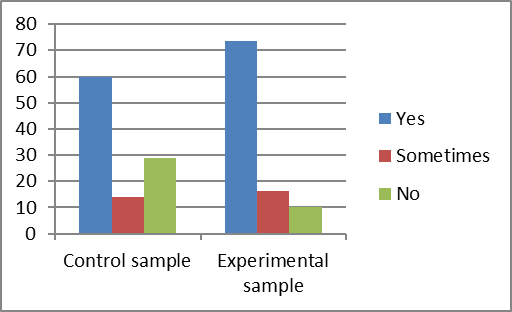
The answers given by the subjects of the two categories of samples are different. In the case of control sample, it was found that, in case of positive answers, they are not motivated, they are confusing and some of them are general, unspecific, vague, undefined. In case of experimental sample, the answers were more nuanced and deeper. Options of answers for the two categories of samples are given in Table
Item No. 2 consists of a closed question, but based on an argument in case of a positive answer: "Do you think that being altruistic is a quality that helps you in life? If so, why?" The values obtained after processing the answers of the subjects are shown in Table
The graphical representation of the answers of the two categories of samples is depicted in Figure
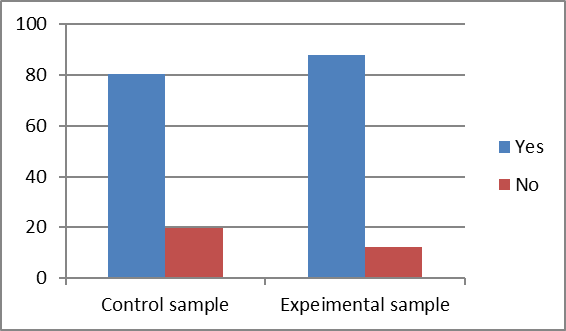
The answers given by the subjects of the two categories of samples are different. In the case of control sample, it was found that arguments are more general and thy are sometimes even missing and in case of experimental sample, the answers are much more nuanced and profound. These types of answers are shown in Table
Item No. 3 consists of an open subjective question: "Have you ever shown an altruistic behavior? Towards whom and in what circumstance?" The values obtained after processing the answers of the subjects are shown in Table
The graphical representation of answers of the two categories of samples is depicted in Figure
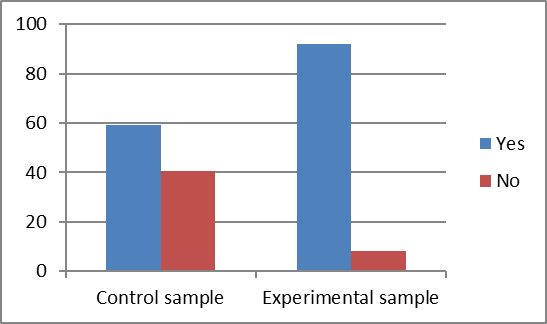
The answers given by the subjects of the two categories of samples are different. In case of the control sample, it was found that the answers are more general, unspecific, vague or they are even missing. In case of experimental sample, the answers were much more relevant and various. These answers are summarized in Table
Item No. 4 consists of a closed question, but based on an argument in case of an affirmative answer: "Do you think you learn something new in the lesson of today (about altruism)? If so, what?" The values obtained after processing the answers of the subjects are shown in Table
The graphical representation of the answers of the two groups of samples depicted in Figure
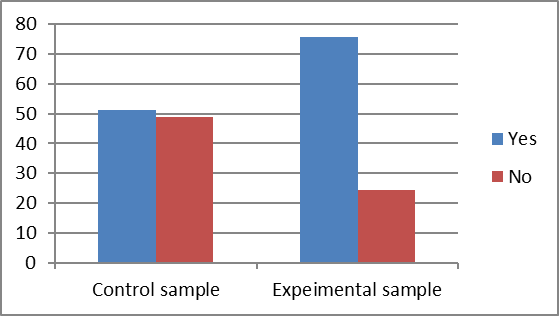
The answers given by the subjects of the two categories of samples are different. In the case of control sample, it was found that the answers are more general, unspecific, vague, undefined. In the case of experimental sample, the answers were more nuanced, various and deep. These answers are given in Table
Item no. 5 consists of a closed question, but accompanied with an argument: " Would you like the Civics lessons take place in the form of a game? If so, why?" The values obtained after processing the answers of the subjects are shown in Table
Graphical representation of answers of the two categories of samples is depicted in Figure
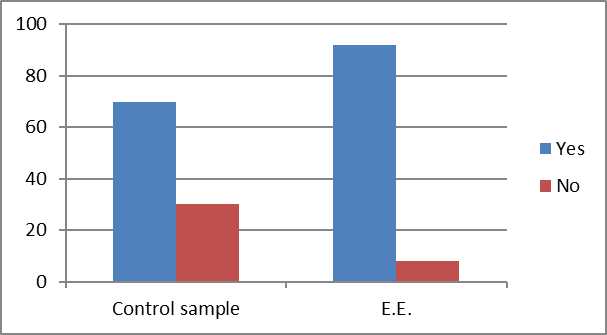
Arguments brought in favor of applying the teaching game in civics lessons were, in case of the control sample, regarded as a potentiality level and they are presented alongside with the arguments of the experimental sample, marking with certainty valences of the teaching game within the civic education classes. Versions of answers according to the two types of samples are shown in Table
Item 6 consists of a closed-ended request, Let's suppose that one of your mates is seriously ill and needs a large amount of money to be surgically operated in a foreign country and you have money gathered in a money box to buy a toy. What would you do in such a case? The values obtained after processing the answers of the subjects are shown in Table
The graphical representation of the answers of the two groups of samples is depicted in Figure
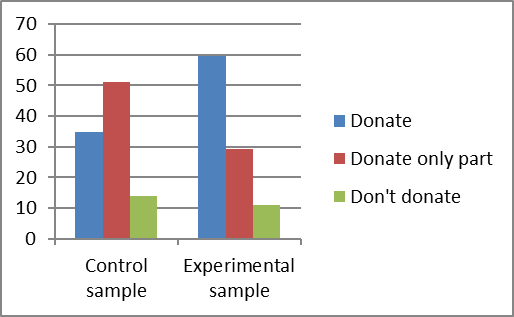
Items 7, 8 and 9 are closed-ended requirements which are behavioral indicators of socio-emotional competence of demonstration of prosocial behaviors corresponding to the dependent variable No.2, represented in Table
Item No. 7 corresponding to the behavioral indicator V.2.1. Those mates who do not work enough to reach their goal do not deserve help when in trouble, shows comparative values between the two samples shown in Figure
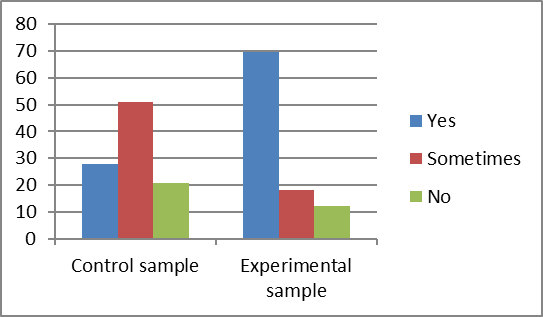
Item No. 8, corresponding to the behavioral indicator V2.2., Within a project you are working on along with other mates of yours, you offer to help if someone needs, shows comparative values between two samples shown in Figure
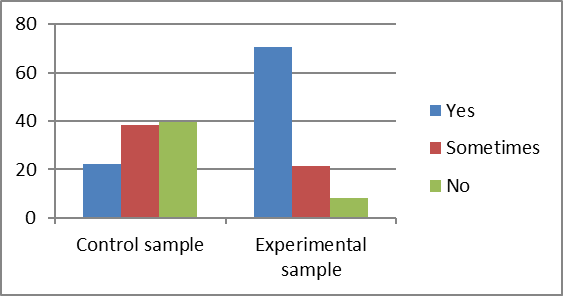
Item no. 9, corresponding to the behavioral indicator V2.3., Within a project you are working on along with some of your mates, you offer to help if someone needs, shows comparative values between two samples shown in Figure
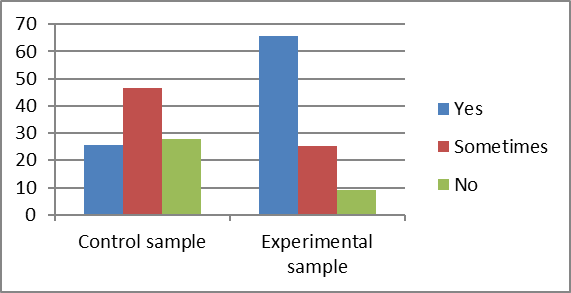
Conclusion
Following the research undertaken by us, we have found as follows:
-By applying teaching strategies with a playful nature within civic education classes, students became more motivated, more receptive to new knowledge also due to the stimulating potential of the educational games
-There has been an increase in the degree of internalization of the moral value of altruism, but also as regards the application of the prosocial behavior in the school context, through mutual assistance, increased attention given to colleagues in difficult situations, elimination of conflicts and reduction of tense states at the level of group of students.
-It turned out that the subjects undergoing the experiment whereby moral lessons were conducted, having playful activities as a teaching strategy, present an increased altruistic and empathetic potential, compared to subjects who have not performed these lessons.
As Kohn (2014) stated in his book entitled Punished by rewards, the real lessons that learn from us (teachers / schoolmasters) are those related to love, justice, respect and compassion only when practiced authentically and positively.
References
- Barbu, D., Boca, A., & Călineci, M. C. (2016), Educație civică. Manual pentru clasa a IV-a [Civic Education. Handbook for the IV-th class]. Bucharest: Editura CD Press.
- Bontaș, I. (2007), Tratat de pedagogie [A Treaty on Pedagogy]. Bucharest: Editura Bic All.
- Chicu, D. (2002), Educația umanistă – componentă indispensabilă a educației prospective, în Dimensiunea spirituală a comportamentului civilizat. Concepte. Repere teoretice și practice. Opinii [Humanistic education - indispensable part of prospective education, in the Spiritual dimension of civilized behavior. Concepts. Theoretical and practical references. Reviews]. Chișinău: Editura Universității Pedagogice de Stat „Ion Creangă”.
- Goleman, D. (2008). Inteligența emoțională [Emotional Intelligence]. Bucharest: Editura Curtea Veche.
- Kohn, A. (2014), Pedepsiți prin recompense [Punished by rewards]. Bucharest: Multi Media Est Publishing.
- Nicola, I. (2003), Tratat de pedagogie școlară [A Treaty on School Pedagogy]. Bucharest: Editura Aramis.
Copyright information

This work is licensed under a Creative Commons Attribution-NonCommercial-NoDerivatives 4.0 International License.
About this article
Publication Date
17 June 2020
Article Doi
eBook ISBN
978-1-80296-084-6
Publisher
European Publisher
Volume
85
Print ISBN (optional)
-
Edition Number
1st Edition
Pages
1-814
Subjects
Teacher, teacher training, teaching skills, teaching techniques, special education, children with special needs
Cite this article as:
Popa, C. D. (2020). Altruism – A Premise In Proving Pro-Social Behaviors. In V. Chis (Ed.), Education, Reflection, Development – ERD 2019, vol 85. European Proceedings of Social and Behavioural Sciences (pp. 150-162). European Publisher. https://doi.org/10.15405/epsbs.2020.06.16
